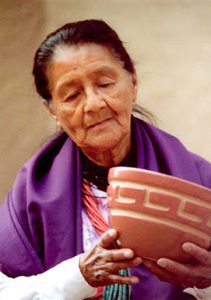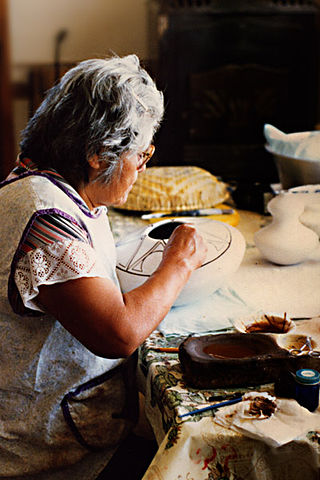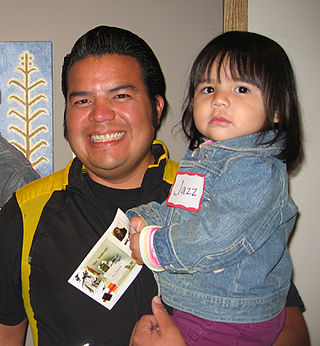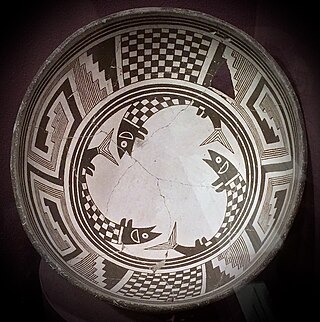Helen Shupla (1928-1985) was an American potter from Santa Clara Pueblo, New Mexico. [1] [2]
Helen Shupla (1928-1985) was an American potter from Santa Clara Pueblo, New Mexico. [1] [2]
Shupla was born in 1928 as a member of the Santa Clara Pueblo, with heritage from Tohono O'odham (Papago). [3]
Helen was active in her pottery work throughout her life, particularly in the 1940s through 1960s.
Shupla is most well known in the art world for her melon-shaped pots; [1] she has been described as "the master of Santa Clara melon bowls". [2] However, she began her career as a more traditional potter, producing black on black pottery and carving bowls, plates, and other vessels. Upon discovering the elasticity of Hopi clay, Helen began to experiment with different techniques of producing pots. Her signature melon pots are made not by carving segments into the clay, but instead by pushing segments out. This process is time-intensive, and it is easy to poke holes that cannot be fixed into the clay. [4] Her husband would sometimes add carvings to her pots after she was done shaping them. [4] Today, Helen's iconic melon pots can reach prices of up to 4 or 5 figures.
Helen earned four first-place ribbons and many second- and third-place ribbons at the Santa Fe Indian Market.
Her works are held by museums including the Heard Museum, [5] the Museum of Fine Arts, Boston, [6] the Fine Arts Museums of San Francisco, [7] the Brooklyn Museum, [8] and the National Museum of the American Indian. [9]
Helen married Kenneth Shupla of the Hopi tribe. They had two daughters and one son. One of the daughter's Jeannie, married Alton Komalestewa of the Hopi tribe. [3] She taught Alton her unique melon pot technique, which he continues to use to this day.
Shupla died in 1985. [2]

Nampeyo was a Hopi-Tewa potter who lived on the Hopi Reservation in Arizona. Her Tewa name was also spelled Num-pa-yu, meaning "snake that does not bite". Her name is also cited as "Nung-beh-yong," Tewa for Sand Snake.

Maria Poveka Montoya Martinez was a Puebloan artist who created internationally known pottery. Martinez, her husband Julian, and other family members, including her son Popovi Da, examined traditional Pueblo pottery styles and techniques to create pieces which reflect the Pueblo people's legacy of fine artwork and crafts. The works of Maria Martinez, and especially her black ware pottery, are in the collections of many museums, including the Smithsonian, the Metropolitan Museum of Art, the Denver Art Museum, and more. The Penn Museum in Philadelphia holds eight vessels – three plates and five jars – signed either "Marie" or "Marie & Julian".

Lucy Martin Lewis was a Native American potter from Acoma Pueblo, New Mexico. She is known for her black-on-white decorative ceramics made using traditional techniques.

Maria Margarita "Margaret" Tafoya was the matriarch of Santa Clara Pueblo potters. She was a recipient of a 1984 National Heritage Fellowship awarded by the National Endowment for the Arts, which is the United States government's highest honor in the folk and traditional arts.
Marie Zieu Chino (1907–1982) was a Native American potter from Acoma Pueblo, New Mexico. Marie and her friends Lucy M. Lewis and Jessie Garcia are recognized as the three most important Acoma potters during the 1950s. Along with Juana Leno, they have been called "The Four Matriarchs" who "revived the ancient style of Acoma pottery." The inspiration for many designs used on their pottery were found on old potsherds gathered to use for temper. Together they led the revival of ancient pottery forms including the Mimbres, Tularosa and other various cultures in the Anasazi region. This revival spread to other potters who also accepted the old styles, which led to new innovative designs and variations of style and form.
Anita Louise Suazo is a Native American potter from Santa Clara Pueblo, New Mexico, United States.
Nathan Youngblood is a Native American potter from Santa Clara Pueblo, New Mexico, United States.

Helen Naha (1922–1993) was the matriarch in a family of well known Hopi-Tewa potters.

Roxanne Swentzell is a Santa Clara Tewa Native American sculptor, ceramic artist, Indigenous food activist, and gallerist. Her artworks are in major public collections and she has won numerous awards.

Helen Cordero was a Cochiti Pueblo potter from Cochiti, New Mexico. She was renowned for her storyteller pottery figurines, a motif she invented, based upon the traditional "singing mother" motif.

Art of the American Southwest is the visual arts of the Southwestern United States. This region encompasses Arizona, New Mexico, and parts of California, Colorado, Nevada, Texas, and Utah. These arts include architecture, ceramics, drawing, filmmaking, painting, photography, sculpture, printmaking, and other media, ranging from the ancient past to the contemporary arts of the present day.

Dextra Quotskuyva Nampeyo was a Native American potter and artist. She was in the fifth generation of a distinguished ancestral line of Hopi potters.
LuAnn Tafoya is a Native American potter. Like her mother, Margaret Tafoya, and her grandmother Sara Fina Tafoya, she creates large ceramic pieces using traditional methods. She is known for her large, highly polished black and red vessels decorated with variations on classic imagery and forms, like traditional bear paw imprints, the avanyu, clouds, birds, kiva steps, winds and gourds.

Angela Tafoya Baca was a Native American artist who was known for her redware and blackware pottery, especially melon bowls and bowls featuring a bear paw design. She had one of the longest careers of the potters in Santa Clara Pueblo in New Mexico. She was a member of the Tewa and a resident of Santa Clara Pueblo.
Susan Folwell is a Native American artist from Santa Clara Pueblo, New Mexico, known for her work in the ceramic industry. Her work ties in Native designs and history and has been used by Folwell to demonstrate her viewpoints on society and politics. Folwell has been described by the Heard Museum as an "innovator in Pueblo pottery".

Jason Garcia is a contemporary Native American artist in the United States, who was born in Santa Clara, New Mexico. His work has been exhibited the Smithsonian in Washington D.C, the Heard Museum in Phoenix, the Palm Springs Art Museum, and many more. He won the 2018 Mentor Fellowship Award under the Native Arts and Cultures Foundation amongst many others.
Deborah Clashin, also known as Debbie Clashin, is a Hopi-Tewa Tobacco Clan potter.

Priscilla Namingha Nampeyo was a Hopi-Tewa potter who was known for her traditional pottery. Namingha mined her own clay and created her own pigments for her large pots. Her work is in the collection of several museums and cultural centers.

Black-on-black ware is a 20th- and 21st-century pottery tradition developed by Puebloan Native American ceramic artists in Northern New Mexico. Traditional reduction-fired blackware has been made for centuries by Pueblo artists and other artists around the world. Pueblo black-on-black ware of the past century is produced with a smooth surface, with the designs applied through selective burnishing or the application of refractory slip. Another style involves carving or incising designs and selectively polishing the raised areas. For generations several families from Kha'po Owingeh and P'ohwhóge Owingeh pueblos have been making black-on-black ware with the techniques passed down from matriarch potters. Artists from other pueblos have also produced black-on-black ware. Several contemporary artists have created works honoring the pottery of their ancestors.

Pueblo pottery are ceramic objects made by the indigenous Pueblo people and their antecedents, the Ancestral Puebloans and Mogollon cultures in the Southwestern United States and Northern Mexico. For centuries, pottery has been central to pueblo life as a feature of ceremonial and utilitarian usage. The clay is locally sourced, most frequently handmade, and fired traditionally in an earthen pit. These items take the form of storage jars, canteens, serving bowls, seed jars, and ladles. Some utility wares were undecorated except from simple corrugations or marks made with a stick or fingernail, however many examples for centuries were painted with abstract or representational motifs. Some pueblos made effigy vessels, fetishes or figurines. During modern times, pueblo pottery was produced specifically as an art form to serve an economic function. This role is not dissimilar to prehistoric times when pottery was traded throughout the Southwest, and in historic times after contact with the Spanish colonialists.